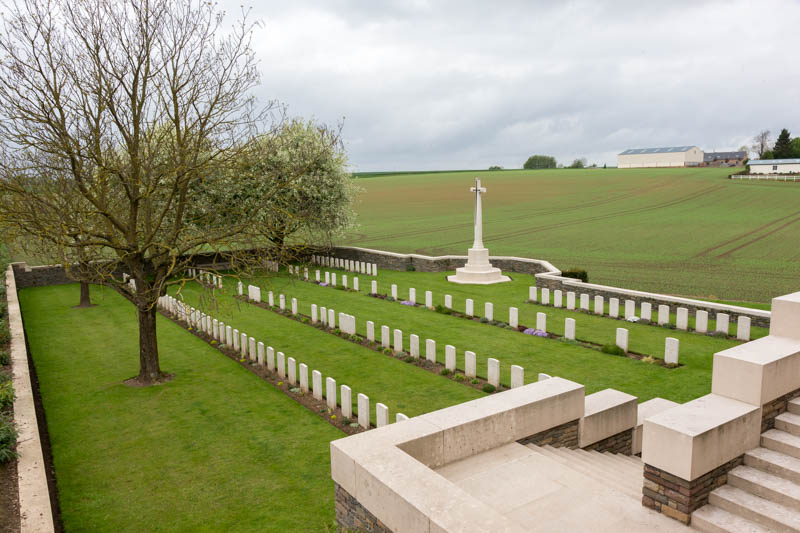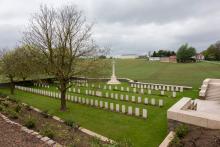Nord
The small village of Louverval is on the north side of the N30, Bapaume to Cambrai road, 13 kilometres north-east of Bapaume, 16 kilometres south-west of Cambrai. Louverval Military Cemetery is situated on the north side of the N30, south of Louverval village and CWGC signposts on the N30 give advance warning of arrival at the Cemetery. On a terrace within the cemetery will also be found the Cambrai Memorial.
The chateau at Louverval, was taken by the 56th Australian Infantry Battalion at dawn on 2 April 1917. The hamlet stayed in Allied hands until the 51st (Highland) Division was driven from it on 21 March 1918 during the great German advance, and it was retaken in the following September. Parts of Rows B and C of the Military Cemetery were made between April and December 1917 and in 1927, graves were brought in from Louverval Chateau Cemetery, which had been begun by German troops in March 1918 and used by Commonwealth forces in September and October 1918. The cemetery now contains 124 First World War burials. On a terrace at one end of the cemetery stands the CAMBRAI MEMORIAL which commemorates more than 7,000 servicemen of the United Kingdom and South Africa who died in the Battle of Cambrai in November and December 1917 and whose graves are not known. Sir Douglas Haig described the object of the Cambrai operations as the gaining of a 'local success by a sudden attack at a point where the enemy did not expect it' and to some extent they succeeded. The proposed method of assault was new, with no preliminary artillery bombardment. Instead, tanks would be used to break through the German wire, with the infantry following under the cover of smoke barrages. The attack began early in the morning of 20 November 1917 and initial advances were remarkable. However, by 22 November, a halt was called for rest and reorganisation, allowing the Germans to reinforce. From 23 to 28 November, the fighting was concentrated almost entirely around Bourlon Wood and by 29 November, it was clear that the Germans were ready for a major counter attack. During the fierce fighting of the next five days, much of the ground gained in the initial days of the attack was lost. For the Allies, the results of the battle were ultimately disappointing but valuable lessons were learnt about new strategies and tactical approaches to fighting. The Germans had also discovered that their fixed lines of defence, no matter how well prepared, were vulnerable. The Cambrai Memorial was designed by H Chalton Bradshaw with sculpture by C S Jagger.



Add new comment